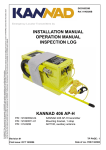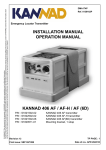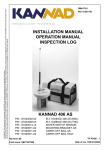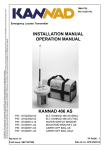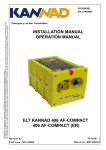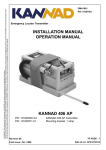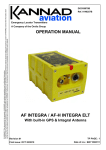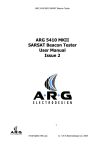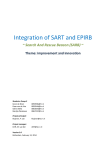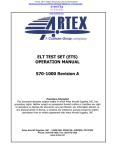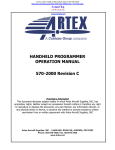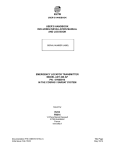Download INSTALLATION MANUAL OPERATION MANUAL INSPECTION LOG
Transcript
© KANNAD: This document is the property of KANNAD and contains proprietary and confidential information. The document is loaned on the express condition that neither the document itself nor the information contained therein shall be disclosed without the express consent of KANNAD and that the information shall not be used by the recipient without prior written acceptance by kannad Furthermore, the document shall be returned immediately to KANNAD upon request. DMA174N Ref. 0139162N Emergency Locator Transmitters INSTALLATION MANUAL OPERATION MANUAL INSPECTION LOG KANNAD 406 AF / AF-H / AF (6D) P/N : S1821502-02 P/N : S1822502-02 P/N : S1821502-06 P/N : S1820511-01 Revision 12 First issue: SEP 02/1999 KANNAD 406 AF transmitter KANNAD 406 AF-H transmitter KANNAD 406 AF(6D) transmitter Mounting bracket, 1 strap TP PAGE : 1 Date of rev. JUN 23/2008 Users are kindly requested to notify KANNAD for any discrepancy, omission or error found in this manual. Please report to our customer support: E-mail: support.sar@kannad Tel.: +33 (0)2 97 02 49 00 INSTALLATION MANUAL OPERATION MANUAL INSPECTION LOG KANNAD 406 AF / AF-H / AF (6D) RECORD OF REVISIONS REV. Nb REVISION DATE INSERTION DATE BY 01 02 03 04 05 06 OCT 14/2003 OCT 14/2003 J. S. 07 NOV 19/2003 NOV 19/2003 J. S. 08 APR 23/2004 APR 23/2004 J. S. 09 JAN 24/2005 JAN 24/2005 J. S 10 JUN 27/2005 JUN 27/2005 J. S. 11 FEB 01/2008 FEB 01/2008 J. S. 12 JUN 23/2008 JUN 23/2008 J.S ROR PAGE: 1 JUN 23/2008 INSTALLATION MANUAL OPERATION MANUAL INSPECTION LOG KANNAD 406 AF / AF-H / AF (6D) RECORD OF REVISIONS PAGE INTENTIONALLY LEFT BLANK ROR PAGE: 2 JUN 23/2008 INSTALLATION MANUAL OPERATION MANUAL INSPECTION LOG KANNAD 406 AF / AF-H / AF (6D) LIST OF EFFECTIVE PAGES SUBJECT PAGE DATE Title Page TP 1 JUN 23/2008 ROR 1 JUN 23/2008 ROR 2 JUN 23/2008 LEP 1 JUN 23/2008 LEP 2 JUN 23/2008 TOC 1 JUN 23/2008 TOC 2 JUN 23/2008 TOC 3 JUN 23/2008 TOC 4 JUN 23/2008 INTRO 1 JUN 23/2008 INTRO 2 JUN 23/2008 1 JUN 23/2008 2 JUN 23/2008 3 JUN 23/2008 4 JUN 23/2008 5 JUN 23/2008 6 JUN 23/2008 101 JUN 23/2008 102 JUN 23/2008 Record of Revisions List of Effective Pages Table of Contents Introduction System Overview System Functional Description and Operation LEP PAGE: 1 JUN 23/2008 INSTALLATION MANUAL OPERATION MANUAL INSPECTION LOG KANNAD 406 AF / AF-H / AF (6D) LIST OF EFFECTIVE PAGES SUBJECT PAGE DATE 103 JUN 23/2008 104 JUN 23/2008 105 JUN 23/2008 106 JUN 23/2008 107 JUN 23/2008 108 JUN 23/2008 201 JUN 23/2008 202 JUN 23/2008 203 JUN 23/2008 204 JUN 23/2008 205 JUN 23/2008 206 JUN 23/2008 207 JUN 23/2008 208 JUN 23/2008 209 JUN 23/2008 210 JUN 23/2008 301 JUN 23/2008 302 JUN 23/2008 303 JUN 23/2008 304 JUN 23/2008 401 JUN 23/2008 Installation / Removal Check Troubleshooting LEP PAGE: 2 JUN 23/2008 INSTALLATION MANUAL OPERATION MANUAL INSPECTION LOG KANNAD 406 AF / AF-H / AF (6D) LIST OF EFFECTIVE PAGES SUBJECT Schematics and Diagrams PAGE DATE 402 JUN 23/2008 501 JUN 23/2008 502 JUN 23/2008 503 JUN 23/2008 504 JUN 23/2008 601 JUN 23/2008 602 JUN 23/2008 Servicing LEP PAGE: 3 JUN 23/2008 INSTALLATION MANUAL OPERATION MANUAL INSPECTION LOG KANNAD 406 AF / AF-H / AF (6D) LIST OF EFFECTIVE PAGES PAGE INTENTIONALLY LEFT BLANK LEP PAGE: 4 JUN 23/2008 INSTALLATION MANUAL OPERATION MANUAL INSPECTION LOG KANNAD 406 AF / AF-H / AF (6D) TABLE OF CONTENTS INTRODUCTION ..................................................................................... 1 SYSTEM OVERVIEW ............................................................................. 1 COSPAS-SARSAT System ................................................................... 1 Description ............................................................................................................. 1 World coverage with the COSPAS-SARSAT system ............................................ 2 Environmental improvements of ELTs ................................................................... 2 G-Switch (shock detectors) .................................................................................... 2 KANNAD 406 ELTs Presentation .......................................................... 3 LINE REPLACEABLE UNITS ............................................................... 4 Transmitter ............................................................................................................ 4 Bracket .................................................................................................................. 4 Remote Control Panel ........................................................................................... 4 Outside antenna .................................................................................................... 4 Design features ..................................................................................... 5 General .................................................................................................................. 5 Mechanical design ................................................................................................. 5 SYSTEM FUNCTIONAL DESCRIPTION AND OPERATION ............ 101 Transmitter ........................................................................................ 101 Controls ............................................................................................. 102 Working mode information ................................................................ 103 Off ...................................................................................................................... 103 Self-Test ............................................................................................................ 103 Armed ................................................................................................................ 104 On ...................................................................................................................... 104 Autonomy .......................................................................................... 105 Electrical characteristics .................................................................... 106 Electrical interface ............................................................................................. 106 Technical Specifications .................................................................... 107 Activation ........................................................................................... 108 Standby mode for automatic activation .............................................................. 108 Manual activation ............................................................................................... 108 Reset ................................................................................................. 108 Manual reset ...................................................................................................... 108 Reset with Remote Control Panel ...................................................................... 108 Self-Test ............................................................................................ 108 INSTALLATION / REMOVAL ............................................................. 201 RTCA / FAR recommendations ......................................................... 201 Registration and Programming ......................................................... 202 TOC PAGE: 1 JUN 23/2008 INSTALLATION MANUAL OPERATION MANUAL INSPECTION LOG KANNAD 406 AF / AF-H / AF (6D) TABLE OF CONTENTS Pin programming option .................................................................................... 202 Installation ......................................................................................... 204 KANNAD 406 AF installation ............................................................................. 206 Fixed wings ..................................................................................................... 206 Helicopters ...................................................................................................... 206 KANNAD 406 AF-H installation ......................................................................... 207 KANNAD 406 AF (6D) installation ..................................................................... 208 First power up ................................................................................... 208 Removal ............................................................................................ 209 CHECK ............................................................................................... 301 Self-test ............................................................................................. 301 Periodicity .......................................................................................................... 301 Self-test procedure ............................................................................................ 301 ELT operational tests ........................................................................ 302 Installation without programming dongle ........................................................... 302 Installation with programming dongle ................................................................ 302 RCP operational tests ....................................................................... 303 406 and 121.5 MHz transmission test ............................................... 304 ELT-Antenna link ............................................................................................... 304 406 MHz ............................................................................................................ 304 121.5 MHz ......................................................................................................... 304 TROUBLESHOOTING ........................................................................ 401 General ............................................................................................. 401 Faults on Self-test ............................................................................. 401 Visual indicator .................................................................................................. 401 3+1 flashes ..................................................................................................... 401 3+2 flashes ..................................................................................................... 401 3+3 flashes ..................................................................................................... 401 3+4 flashes ..................................................................................................... 401 Other faults detected ......................................................................... 401 Buzzer ............................................................................................................... 401 Buzzer does not operate ................................................................................. 401 Buzzer operates permanently when ELT in ARM mode ................................. 401 SCHEMATICS & DIAGRAMS ............................................................ 501 Outline Dimensions ........................................................................... 501 Drilling Mask ..................................................................................... 502 Wiring ................................................................................................ 503 SERVICING ........................................................................................ 601 Maintenance Schedule ..................................................................... 601 TOC PAGE: 2 JUN 23/2008 INSTALLATION MANUAL OPERATION MANUAL INSPECTION LOG KANNAD 406 AF / AF-H / AF (6D) TABLE OF CONTENTS Periodic inspection ............................................................................................ 601 Every 6 years .................................................................................................... 601 Battery replacement .......................................................................................... 602 TOC PAGE: 3 JUN 23/2008 INSTALLATION MANUAL OPERATION MANUAL INSPECTION LOG KANNAD 406 AF / AF-H / AF (6D) TABLE OF CONTENTS PAGE INTENTIONALLY LEFT BLANK TOC PAGE: 4 JUN 23/2008 INSTALLATION MANUAL OPERATION MANUAL INSPECTION LOG KANNAD 406 AF / AF-H / AF (6D) INTRODUCTION The instructions in this manual provide the information necessary for the installation and the operation of KANNAD 406 AF, AF-H and AF (6D) ELTs. Servicing instructions are normally performed by shop personnel. For servicing and maintenance instructions, refer to CMM 25-63-01. For regulatory requirements, please consult your national aviation authority. PAGE INTRO 1 JUN 23/2008 INSTALLATION MANUAL OPERATION MANUAL INSPECTION LOG KANNAD 406 AF / AF-H / AF (6D) PAGE INTENTIONALLY LEFT BLANK PAGE INTRO 2 JUN 23/2008 INSTALLATION MANUAL OPERATION MANUAL INSPECTION LOG KANNAD 406 AF / AF-H / AF (6D) SYSTEM OVERVIEW 1. COSPAS-SARSAT System A. Description Launched in the early eighties by the four founder countries (Canada, France, Russia, USA), the COSPAS-SARSAT system provides satellite aid to search and rescue (SAR) operations for maritime, aeronautical and terrestrial vehicles anywhere in the world. It uses distress beacons fitted on mobiles and a constellation of LEO and GEO satellites which relay the 121.5 / 243 MHz signals and process the 406 MHz signal to ground stations (LUT) where the beacon positions are determined (with a precision of 10 NM with 121.5 / 243 signals and less than 2 NM with 406 signals). Several types of beacons are designed to match the various applications of the COSPAS-SARSAT system: • EPIRB (Emergency Position Indicating Radio Beacon) for maritime applications. • ELT (Emergency Locator Transmitter) for aeronautical applications. • PLB (Personal Locator Beacon) for land expeditions. Figure 1: COSPAS-SARSAT System PAGE: 1 JUN 23/2008 INSTALLATION MANUAL OPERATION MANUAL INSPECTION LOG KANNAD 406 AF / AF-H / AF (6D) B. World coverage with the COSPAS-SARSAT system The major improvement is the use of the COSPAS-SARSAT system for processing aeronautical emergencies. The difference with the 121.5 / 243 MHz is that the 406 MHz transmission carries digital data which enable the identification of the aircraft in distress and facilitate SAR operation (type of the aircraft, number of passengers, type of emergency). The 406 MHz message is transmitted to the COSPAS-SARSAT satellites. This message is downloaded to one of the 64 ground stations (44 LEOLUTs and 20 GEOLUTS). The aircraft is located by Doppler effect by the LEO satellites with a precision better than 2 NM (4 km) at any point of the earth. C. Environmental improvements of ELTs The certification of an ELT includes a range of severe mechanical tests: • resistance to flame; • impact and crush tests; • resistance to 100 G and 500 G shocks; • watertightness; • antideflagration; • extreme temperatures (-20°C to 55°C for more than 48 hours). D. G-Switch (shock detectors) The shock detectors currently equipping automatic ELTs are the cause of a large number of false alarms. Major work has consisted in studying aircraft crashes (study made by the " Crash Research Institute ") and evaluating the acceleration amplitudes involved. As a consequence, G-Switch specifications have been modified to optimize the accuracy of the crash detection. PAGE: 2 JUN 23/2008 INSTALLATION MANUAL OPERATION MANUAL INSPECTION LOG KANNAD 406 AF / AF-H / AF (6D) 2. KANNAD 406 ELTs Presentation The KANNAD 406 AF / AF-H / AF (6D) are composed of: 1. a transmitter; 2. a mounting bracket; 3. a remote control panel (mandatory if ELT controls are not available from the pilot’s position, refer to RTCA/DO-183, RTCA/DO-204, EUROCAE ED-62); 4. an outside antenna; 5. a "Programming Dongle" for pin-programming function (option); 6. CS144 Interface Module (option). The transmitter, bracket, Programming Dongle and CS144 Interface Module are installed in the aircraft near the tail. The outside antenna is mounted on the fuselage near the tail. The remote control panel is installed in the cockpit and connected to the ELT with a 4 or 5 wire bundle. Figure 2: ELT system description The KANNAD 406 AF and AF(6D) are designed to be installed on fixed wing aircraft or helicopters. The KANNAD 406 AF-H is to be installed only on helicopters. PAGE: 3 JUN 23/2008 INSTALLATION MANUAL OPERATION MANUAL INSPECTION LOG KANNAD 406 AF / AF-H / AF (6D) 3. LINE REPLACEABLE UNITS A. Transmitter The KANNAD 406 AF / AF-H / AF (6D) is an ELT designed to be installed on board aircraft to transmit a distress signal on 3 frequencies: • 406 MHz (COSPAS-SARSAT frequency) for precise pinpointing and identification of the aircraft in distress. • 121.5 and 243 MHz used for homing in the final stages of the rescue operations. The KANNAD 406 AF / AF-H / AF (6D) are certified as Automatic Fixed (AF) ELTs and only work with a three-frequency outside antenna. B. Bracket The bracket installed near the tail is designed to fix the ELT with a Velcro® strap. This enables quick removal of the ELT for maintenance or exchange. C. Remote Control Panel A remote control panel is available for installation in the cockpit in order to enable the pilot to monitor and control the ELT status. The following controls are to be found on the panel: • 3-position switch (ON, ARMED, RESET&TEST); • red or amber visual indicator; • beeper (on certain versions). The remote control panel is connected to the ELT via a 4 or 5-wire cable equipped with a "Programming Dongle" or a DIN 12 connector on the ELT side and the connector corresponding to the Remote Control Panel version on the other side. D. Outside antenna The outside antenna, also installed near the tail, can be either rod or blade type according to aircraft speed. Connection to the ELT will be carried out with a 50 Ohm coaxial cable (RG58 for example) ended with a BNC connector. IMPORTANT NOTICE: KANNAD recommends a cable with radio electric properties similar or better to those of a RG58 cable. PAGE: 4 JUN 23/2008 INSTALLATION MANUAL OPERATION MANUAL INSPECTION LOG KANNAD 406 AF / AF-H / AF (6D) 4. Design features A. General The KANNAD 406 AF / AF-H / AF (6D) belong to the AF type of ELTs which are permanently attached to an aircraft. B. Mechanical design The KANNAD 406 AF / AF-H / AF (6D) are made of moulded plastic with excellent mechanical resistance (ASA/PC, light yellow colour). The housing is designed with no sharp edges. Figure 3: KANNAD 406 AF / AF-H / AF (6D) with mounting bracket PAGE: 5 JUN 23/2008 INSTALLATION MANUAL OPERATION MANUAL INSPECTION LOG KANNAD 406 AF / AF-H / AF (6D) PAGE INTENTIONALLY LEFT BLANK PAGE: 6 JUN 23/2008 INSTALLATION MANUAL OPERATION MANUAL INSPECTION LOG KANNAD 406 AF / AF-H / AF (6D) SYSTEM FUNCTIONAL DESCRIPTION AND OPERATION 1. Transmitter The KANNAD 406 AF / AF-H / AF (6D) can be activated either automatically when the crash occurs (thanks to a shock sensor) or manually (thanks to a switch on the transmitter itself or on a Remote Control Panel). The KANNAD 406 AF / AF-H / AF (6D) are designed to transmit on three frequencies (121.5, 243 and 406 MHz). The two basic emergency frequencies (121.5 and 243 MHz ) are mainly used for homing in the final stages of the rescue operations. The 406 MHz frequency is used by the COSPAS-SARSAT satellites for precise pinpointing and identification of the aircraft in distress. Once activated, the transmitter operates continuously on 121.5 and 243.0 MHz with an output power of 100 mW on each frequency. The modulation is an audio frequency sweeping downwards from 1420 Hz to 490 Hz with a repetition rate of 3 Hz. During the first 24 hours of operation, a digital message is transmitted on 406.025 MHz every 50 seconds. The output power on 406 MHz is 5 W. The KANNAD 406 AF, AF-H and AF (6D) can transmit two types of messages on 406 MHz: • 112 bits for a short message (identification only); • 144 bits for a long message (identification + aircraft position). The long messages are generated by a separate interface module (called CS144) connected to the ELT and either to a NAV equipment of the aircraft by RS232, RS422 or RS485 link or to an ARINC429 bus. PAGE: 101 JUN 23/2008 INSTALLATION MANUAL OPERATION MANUAL INSPECTION LOG KANNAD 406 AF / AF-H / AF (6D) 2. Controls The following controls are to be found on the ELT front panel (from left to right): 1. 3-position switch ARM/OFF/ON; 2. Visual indicator (red); 3. DIN 12 connector for connection to Remote Control Panel, CS144 interface module, dongle or programming equipment; 4. BNC connector for the antenna. Figure 101: Front Panel The visual indicator gives an indication on the working mode of the beacon: • after the self test: a series of short flashes indicate the self test failed, one long flash indicates a correct self test; • in operating mode: periodic flashes during 121.5 / 243 transmission; • long flash during 406 transmission. A buzzer gives audio information on the beacon working: • continuous tone during self test; • 2 beeps per second during 121.5 / 243 transmission; • silence during 406 transmission. PAGE: 102 JUN 23/2008 INSTALLATION MANUAL OPERATION MANUAL INSPECTION LOG KANNAD 406 AF / AF-H / AF (6D) 3. Working mode information The KANNAD 406 AF / AF-H / AF (6D) have 4 different modes: • Off. • Self-test (temporary mode). • Armed (standby mode to enable automatic activation by the shock sensor or by the remote control panel). • On (transmission). Transmission is effective if the beacon is activated (either manually on the ELT control panel, remotely by the "ON" switch on the remote control panel or automatically by the shock sensor) =. A. Off The ELT is off when the switch is in position "OFF". No part of the ELT is energized. This mode must only be selected when the ELT is removed from the aircraft or parked for a long period or for maintenance. B. Self-Test The self-test mode is a temporary mode (max duration 5 sec) in which the ELT checks the main characteristics of the transmitter (Battery voltage, Programming...) and enables digital communication with a programming and test equipment. This mode is selected: • when switching from "OFF" to "ARM"; • when switching to "RESET / TEST" on the Remote Control Panel (provided that the switch of the ELT is in the "ARM" position); • when switching to "ON" prior to transmission. The buzzer operates during the self-test procedure. After about 3 seconds, the test result is displayed on the visual indicator as follows: • One long flash indicates valid test. • A series of short flashes indicates false test result. The number of flashes indicates the type of failure: • 3 + 1 = LOW BATTERY VOLTAGE. • 3 + 2 = LOW TRANSMISSION POWER. • 3 + 3 = FAULTY VCO LOCKING (FAULTY FREQUENCY). • 3 + 4 = NO IDENTIFICATION PROGRAMMED. It is recommended to test the ELT regularly in order to detect any possible failure (Refer to A. Periodicity, page 301).The number of self-tests carried out is recorded. This information is available when the ELT is connected to a PAGE: 103 JUN 23/2008 INSTALLATION MANUAL OPERATION MANUAL INSPECTION LOG KANNAD 406 AF / AF-H / AF (6D) programming and test equipment (PR600). C. Armed In order to enable activation by the G-Switch or with the Remote Control Panel, the ELT must be in standby mode with the switch in the ARM position. This mode is mandatory during flight. The ELT should remain in the ARM position all the time except when the ELT is removed from the aircraft or if the aircraft is parked for a long period or for maintenance. The Remote Control Panel is energized by the ELT when the ELT’s Switch is in the "ARM" position. D. On This mode is selected: • manually by switching to position "ON"; • by switching the Remote Control Panel switch to "ON" (provided that the ELT switch is in the "ARM" position); • when a crash occurs (provided that the ELT switch is in position "ARM"). When this mode is selected, the ELT starts transmission: • on 121.5 MHz & 243 MHz immediately (continuous transmission); • on 406 MHz after 50 seconds (406 burst every 50 sec during 24 hours). The red visual indicator on the ELT (and on the remote control panel if installed) flashes and the buzzer operates. In case of accidental activation, the ELT can be reset either by switching it to "OFF" or by switching to "RESET" on the Remote Control Panel. The number of 406 MHZ bursts effectively transmitted is recorded. This information is available when the ELT is connected to a programming and test equipment (PR600). PAGE: 104 JUN 23/2008 INSTALLATION MANUAL OPERATION MANUAL INSPECTION LOG KANNAD 406 AF / AF-H / AF (6D) 4. Autonomy The energy is provided by a battery pack composed of 3 LiMnO2 D cells (See pages 108 & 602 for Kit battery reference). Lithium cells, lithium batteries and equipment containing such batteries are subjected to regulations and classified under class 9 as from 1st of January 2003. The autonomy of the 121.5/243 transmission is close to 100 hours at -20°C with new batteries. In the worse conditions possible, a distress is pinpointed 5.5 hours maximum after the ELT activation and the position is subsequently updated (if necessary) every 2 hours. As it is therefore preferable to keep the battery power for 121.5/243 MHz homing frequency transmission for the rescue operations, the 406 MHz transmission is deliberately stopped after 24 hours to extend the 121.5/243 transmission for as long as possible. The transmitter battery expiry date is fixed at 6 years after manufacturing. If no activation of the ELT occurs during the battery lifetime, it shall be replaced every 6 years(see note below). NOTE: The useful life time of batteries is twelve (12) years. To be in compliance with FAR regulations, they have to be replaced every six (6) years when 50 percent of their useful life has expired. PAGE: 105 JUN 23/2008 INSTALLATION MANUAL OPERATION MANUAL INSPECTION LOG KANNAD 406 AF / AF-H / AF (6D) 5. Electrical characteristics Transmitter power supply: 3 x LiMnO2 D type cells. A. Electrical interface When installed on board, the ELT has to be connected: • to a Remote Control Panel via a DIN12 connector; • to an outside antenna via a BNC connector. The DIN12 connector is also used to connect a programming dongle, a CS144 interface or a programming and test equipment. J1 This connector is dedicated for connection to the Remote Control Panel, to the Programming or Maintenance Dongles, to the CS144 interface and/or to the programming equipment (PR600). IMPORTANT: Shielded cables are recommended. The required wires are AWG24. J1 Viewed from Front Face PIN Signal Name Destination Direction J1-A RCP TEST/RESET RCP IN J1-B DONGLE RX SMM / PGM IN J1-C DONGLE CS SMM OUT J1-D DONGLE SK SMM OUT J1-E DONGLE TX SMM / PGM OUT J1-F DONGLE ALE2P SMM OUT J1-G RCP COMMON RCP OUT J1-H RCP BUZZER RCP(*) OUT J1-J RCP LED RCP OUT J1-K RCP ON RCP IN J1-L DONGLE GND SMM / PGM OUT J1-M N/C Table 1: J1 connector pin-out (*)This wire is not used with some versions of Remote Control Panels. For precise information, refer to Remote Control Panel technical description. J2 Connector J2 is used to connect the outside antenna through a 50 Ω coaxial cable. PAGE: 106 JUN 23/2008 INSTALLATION MANUAL OPERATION MANUAL INSPECTION LOG KANNAD 406 AF / AF-H / AF (6D) IMPORTANT: The length of the coaxial cable should not exceed 2 meters (6 ft) for a standard RG58 or equivalent coaxial cable. If the cable length exceeds 2 meters, a low loss cable of attenuation less than 1 dB must be used. 6. Technical Specifications TYPE • Three-frequency ELT (121,5 / 243,0 / 406,025 MHz) • Automatic fixed • COSPAS-SARSAT Class II (-20°C to +55°C). 406 MHz TRANSMISSION • Frequency: 406.025 MHz+/-2 kHz • Output power: 5W (37 dBm +/- 2 dB) • Modulation type: 16K0G1D (Biphase L encoding) • Transmission duration: 440ms (short message) every 50 sec. compatible with long message transmission (520ms) • Autonomy: Over 24 hours at -20°C 121.5/243 MHz TRANSMISSION • Frequencies: 121.5 MHz +/- 6 kHz 243.0 MHz +/- 12 kHz • Output power:100 to 400 mW (20dBm to 26 dBm) for each frequency • Modulation type: 3K20A3X • Modulation rate: between 85 and 100% • Frequency of modulation signal: 1420 Hz to 490 Hz with decreasing sweep • Autonomy: Over 48 hours at -20°C CONTROLS • ARM / OFF / ON switch • Red visual indicator • BNC antenna connector • DIN12 connector for remote control panel and pin programming option. • Buzzer G-SWITCH SENSOR Mechanical G-switch sensor compliant with EUROCAE ED62 specifications 6 G-switch assembly in ELT, KANNAD 406 AF (6D) (S1821502-06) BATTERY KIT BAT300, P/N : S1820516-99 3 x LiMnO2 D type cells for transmitter power supply Replacement every 6 years HOUSING Material: Molded plastic Color: Yellow Transmitter dimensions: 172 mm x 82 mm x 82 mm Overall dimensions: max 181 mm x 100 mm x 94 mm Weight (including battery): AF: typical 1110 g / max 1180 g. AF-H: typical 1120 g / max 1190 g AF (6D): typical 1190 g / max 1260 g. Tightness: O-rings ENVIRONMENTAL CONDITIONS RTCA DO-160D / EUROCAE Ch1 to 25 [D1]XBA[ED62][SYLMC]AWXXXXZXXX ZWL[(A1)(A2)(A3)XX]XXA QUALIFICATIONS JTSO-2C91a & JTSO-2C126 (EUROCAE ED62) TSO-C91a & TSO-C126 (RTCA DO183 & DO204) PAGE: 107 JUN 23/2008 INSTALLATION MANUAL OPERATION MANUAL INSPECTION LOG KANNAD 406 AF / AF-H / AF (6D) 7. Activation A. Standby mode for automatic activation In order to be automatically activated by the crash sensor, the ELT must be in standby mode. This mode is mandatory during the flight. We recommend to switch the ELT off only when the aircraft is parked for a long period or for a maintenance operation. • Check that the antenna is correctly connected. • Switch to " ARM". To operate the ELT with the Remote Control Panel, ensure that: • The ELT switch is in the "ARM" position. B. Manual activation • Check that the antenna is correctly connected. • Switch to " ON " (either on the ELT or on the Remote Control Panel): - The ELT starts with the self-test sequence. - 121.5 / 243 MHz transmission starts immediately after the self-test. - 406 MHz starts after 50 seconds (406 MHz burst every 50 sec during 24 hours). - During transmission, buzzer operates and visual indicator flashes. 8. Reset It is possible to stop the ELT in case of unintentional activation. Regulations state that no transmission must be interrupted unless every means are used to contact and inform the Air Traffic Controller of this action. Important notice: As 406 MHz transmission is effective 50 seconds after the ELT activation, if it is reset within this delay, no further radio contact will be necessary. A. Manual reset • Switch to " OFF " then to "ARM". B. Reset with Remote Control Panel • The switch has to be in the "ARM" position on the ELT. • Switch to " RESET & TEST" on the remote control. 9. Self-Test Refer to 1. Self-test, page 301 PAGE: 108 JUN 23/2008 INSTALLATION MANUAL OPERATION MANUAL INSPECTION LOG KANNAD 406 AF / AF-H / AF (6D) INSTALLATION / REMOVAL Only PART / FAR 145 certified service stations can install the KANNAD 406 AF / AF-H / AF (6D) ELT. 1. RTCA / FAR recommendations "The conditions and tests required for TSO approval of this ELT are minimum performance standards. It is the responsibility of those desiring to install this ELT on a specific type or class of aircraft to determine that the aircraft installation conditions are within the TSO standards. The ELT may be installed only if further evaluation by the applicant documents an acceptable installation and it is approved by the Administrator". (TSO-C91a) "The ELT must be attached to the aircraft in such a manner that the probability of damage to the transmitter in the event of a crash impact is minimized." (FAR 91.207) "The ELT shall be mounted to primary aircraft load-carrying structures such as trusses, bulkheads, longerons, spars, or floor beams (not aircraft skin). The mounts shall have a maximum static local deflection no greater than 2.5 mm (0.1 inch) when a force of 450 Newton (100 lbf) is applied to the mount in the most flexible direction. Deflection measurements shall be made with reference to another part of the airframe not less than 0.3 meters (1 foot) nor more than 1.0 meter (3 feet) from the mounting location." (RTCA-DO183) The ELT should not be installed at less than 60 cm (2 ft) of a compass or flux gate. Use cable of loss ≤ 1dB. The ELT front panel should be easily accessible to connect the outside antenna and the remote control panel device and to check the ELT good operation (controls and lights). If no remote control is used, "ELT controls and displays installed for in-flight use shall be readily accessible from the pilot's normal seated position. The pilot shall have an unobstructed view of displayed data when in the normal seated position." (RTCA DO-183). PAGE: 201 JUN 23/2008 INSTALLATION MANUAL OPERATION MANUAL INSPECTION LOG KANNAD 406 AF / AF-H / AF (6D) 2. Registration and Programming The ELT must be registered prior to installation on board. The registration card available from the local registration authority must be completed and returned to this authority. The "Programming Datasheet" (DIM0300) must be completed and returned to your distributor. Any change of ownership shall also be declared and registered with the local registration authority and with the distributor. The KANNAD 406 AF / AF-H / AF (6D) are fully compatible with the four programming protocols defined by the COSPAS-SARSAT C/S G005 document: • Serialised Number. • Aircraft 24 bit Address (the same as MODE S ATC or TCAS). • Aircraft Operator Designator + serialised number up to 4096. • Aircraft Nationality and Registration marking (Tail Number). This identification consists of up to 7 alphanumeric characters. Programming of the ELT can be carried out either: • by KANNAD or the distributor (order must include programming details). • in the shop with a programming and test equipment (PC interface and Windows® software). • on board the aircraft with a programming equipment or programming dongle. This operation takes less than 2 minutes and does not need any hardware operation. The identification is simply downloaded in the ELT when connected to the KANNAD programming equipment via the DIN 12 connector. A. Pin programming option The KANNAD 406 AF / AF-H / AF (6D) offer pin-programming capabilities to facilitate maintenance operations especially in case of removals and/or replacement. A special DIN 12 connector with a Serial Memory Module (called "Programming Dongle") is connected to the ELT when installed on board. This Programming Dongle contains the identification information of the aircraft and remains on board the aircraft. When an unprogrammed ELT is installed and connected to this Programming Dongle and the "ELT" is switched to "ARM", it automatically updates its own memory with the identification data contained in the PAGE: 202 JUN 23/2008 INSTALLATION MANUAL OPERATION MANUAL INSPECTION LOG KANNAD 406 AF / AF-H / AF (6D) Programming Dongle memory. When the ELT is removed from the aircraft, it keeps its identification data. For maintenance purposes, it is possible to delete the identification information of the ELT by connecting a "Maintenance Dongle" to the ELT. Any accidental transmission with this "maintenance dongle" will not involve SAR operation as the identification code transmitted is recognised by COSPAS-SARSAT as "not on board". When a maintenance dongle is connected: • Country code is 227 (France). • Protocol is Test. • Identification number is SI + 5 digits (the last 5 digits of CSN number) or K + 6 digits (the 6 digits of the CSN number). If the pin programming option is selected by the operator, the following equipment are required: • a "Programming Dongle" on each aircraft; • a "Maintenance Dongle" on each ELT spare. Figure 201: Maintenance Dongle PAGE: 203 JUN 23/2008 INSTALLATION MANUAL OPERATION MANUAL INSPECTION LOG KANNAD 406 AF / AF-H / AF (6D) 3. Installation • Determine the location of the ELT on board according to FAR/RTCA recommendations. • Determine the axis of the ELT, according to the type of KANNAD 406: - KANNAD 406 AF: Refer to A. KANNAD 406 AF installation, page 206; - KANNAD 406 AF-H: Refer to B. KANNAD 406 AF-H installation, page 207; - KANNAD 406 AF (6D): Refer to C. KANNAD 406 AF (6D) installation, page 208. • Drill 4 holes Ø 6 mm in the aircraft structure according to "Drilling mask". Holes 4,5,6,7 shall be preferred. • If the aircraft structure is not solid enough to withstand a 500 kg traction on the bracket, a reinforcement plate (not supplied) should be installed as shown Figure 202: Bracket installation. • Fix the bracket with the 4 screws, 8 washers and 4 nylstop nuts supplied. IMPORTANT: tighten to a torque between 4 and 5 Newton x meter. Screw Flight Direction Arrow Washer (small) Mounting bracket 9 6 3 10 7 4 1 8 5 Ø 6 mm holes Aircraft structure Washer (large) Nylstop nut Reinforcement plate (not supplied) Figure 202: Bracket installation PAGE: 204 JUN 23/2008 INSTALLATION MANUAL OPERATION MANUAL INSPECTION LOG KANNAD 406 AF / AF-H / AF (6D) • Verify that the ELT identification label matches the aircraft tail number. • Mount the transmitter on the bracket. • Slide the self-stripping strap thought the buckle and fasten it tightly. Figure 203: Installing the transmitter on the bracket • Connect the outside antenna to the BNC connector (Refer to Figure 204: Installation, controls and connectors) as shown Figure 2: ELT system description page 3. Note regarding the outside antenna: The installation of the outside antenna is not covered by this manual. Refer to antenna manufacturer's instructions. If the aircraft is not metallic, the antenna should be mounted on a metallic counterpart. • Connect the Remote Control Panel (or CS144) to the DIN12 connector (Refer to Figure 204: Installation, controls and connectors) as shown Figure 2: ELT system description page 3. • Set the 3-position switch (Refer to Figure 204: Installation, controls and connectors) to ARM. Figure 204: Installation, controls and connectors • Perform the first power up procedure (Refer to 4. First power up, page 208). PAGE: 205 JUN 23/2008 INSTALLATION MANUAL OPERATION MANUAL INSPECTION LOG KANNAD 406 AF / AF-H / AF (6D) A. KANNAD 406 AF installation Figure 205: KANNAD 406 AF installation (1) Fixed wings The G-Switch sensor axis shall be pointed to sense the primary crash pulse along the longitudinal axis of the aircraft (with maximum tolerance of 15°). Consequently, the KANNAD 406-AF shall be mounted with the arrow of the "Direction of Flight" label pointed towards the front of the aircraft. (2) Helicopters The KANNAD 406 AF can be installed in its standard version on helicopter. The ELT unit should be mounted: • with the front face connectors pointing downwards at a 45° angle to the yaw axis; • and with "Direction of Flight" arrow towards the front of the helicopter. NOTE: Should the KANNAD 406 AF be installed on board helicopter, it will be necessary to make a special mounting base to install the ELT. PAGE: 206 JUN 23/2008 INSTALLATION MANUAL OPERATION MANUAL INSPECTION LOG KANNAD 406 AF / AF-H / AF (6D) B. KANNAD 406 AF-H installation Figure 206: KANNAD 406 AF-H installation IMPORTANT: The KANNAD 406 AF-H is designed to be installed on board helicopters only. The "Direction of Flight " arrow shall point towards the front or the bottom of the helicopter (and not pointing 45° downwards): • If the KANNAD 406 AF-H is installed with the "Direction of Flight " arrow pointing towards the front of the helicopter, the ELT shall be mounted with the upper side pointing towards the top of the helicopter. • If the KANNAD 406 AF-H is installed with the "Direction of Flight " arrow pointing towards the bottom of the helicopter, the ELT shall be installed with the lower side pointing towards the front of the helicopter. PAGE: 207 JUN 23/2008 INSTALLATION MANUAL OPERATION MANUAL INSPECTION LOG KANNAD 406 AF / AF-H / AF (6D) C. KANNAD 406 AF (6D) installation Figure 207: KANNAD 406 AF (6D) installation For fixed wings aircraft and helicopters, the KANNAD 406 AF (6D) shall be mounted in roll or pitch plane, either parallel or perpendicular to the aircraft flight direction. 4. First power up Perform the following tests: 1. ELT operational tests: Refer to 2. ELT operational tests, page 302 2. RCP operational tests: Refer to 3. RCP operational tests, page 303 3. 406 & 121.5 MHz transmission tests (optional): Refer to 4. 406 and 121.5 MHz transmission test, page 304 PAGE: 208 JUN 23/2008 INSTALLATION MANUAL OPERATION MANUAL INSPECTION LOG KANNAD 406 AF / AF-H / AF (6D) 5. Removal • Switch the ELT to OFF (Refer to Figure 204: Installation, controls and connectors). • Disconnect the Remote Control Panel (or CS144) from the DIN12 connector (Refer to Figure 204: Installation, controls and connectors). • Disconnect the outside antenna from the BNC connector (Refer to Figure 204: Installation, controls and connectors). • Unfasten the self-stripping strap. • Remove the transmitter from the bracket. Figure 208: Removing the transmitter PAGE: 209 JUN 23/2008 INSTALLATION MANUAL OPERATION MANUAL INSPECTION LOG KANNAD 406 AF / AF-H / AF (6D) PAGE INTENTIONALLY LEFT BLANK PAGE: 210 JUN 23/2008 INSTALLATION MANUAL OPERATION MANUAL INSPECTION LOG KANNAD 406 AF / AF-H / AF (6D) CHECK 1. Self-test A. Periodicity It is recommended by the manufacturer to test the ELT to detect any possible failure. It is recommended to perform a self-test once a month by pilot or maintenance personnel from the cockpit (Remote Control Panel) but it should not be done more than once a week. However, each self-test consumes energy from the battery. Should self-tests be carried out more often than the maximum allowed, the battery life-time might be shorter than specified. Do not perform Self-test without the antenna connected. B. Self-test procedure • Check that the antenna is correctly connected. • Switch from position "OFF" to position "ARM" or press "RESET & TEST" on the Remote Control Panel (ensure that the ELT switch is in the "ARM" position). - The buzzer operates during the whole Self-test procedure. - After a few seconds, the test result is displayed with the visual indicator as follows: • One long flash indicates that the system is operational and that no error conditions were found. • A series of short flashes(see Remark below) indicates the test has failed. If self-test fails, contact the distributor as soon as possible. Unless a waver is granted, flight should be cancelled. Remark:The number of flashes gives an indication of the faulty parameter detected during the self-test. 3+1 LOW BATTERY VOLTAGE 3+2 LOW RF POWER 3+3 FAULTY VCO LOCKING (FAULTY FREQUENCY) 3+4 NO IDENTIFICATION PROGRAMMED PAGE: 301 JUN 23/2008 INSTALLATION MANUAL OPERATION MANUAL INSPECTION LOG KANNAD 406 AF / AF-H / AF (6D) 2. ELT operational tests A. Installation without programming dongle • connect RCP to J1 and outside antenna to J2; • switch the ELT from OFF to ARM; • check that the Self-Test result is OK (one long flash). B. Installation with programming dongle • connect the outside antenna to J2; • switch the ELT from OFF to ARM; • check that the Self-Test fails (3+4 flashes); • if not, connect a maintenance dongle to J1: - Switch the ELT from OFF to ARM; - Check that the Self-Test fails (3+4 flashes); - Remove the maintenance dongle from J1. • connect the programming dongle to J1; • switch the ELT from OFF to ARM: the buzzer operates during the whole self-test procedure, after a few seconds the LED displays the result. • check that the Self-Test result is OK (one long flash). PAGE: 302 JUN 23/2008 INSTALLATION MANUAL OPERATION MANUAL INSPECTION LOG KANNAD 406 AF / AF-H / AF (6D) 3. RCP operational tests Check correct operation of RCP LED and external buzzer by switching ELT and RCP as described in the sequential procedure hereunder (with ELT switch in the "ARM" position). Figure 301: RCP LED and buzzer operation IMPORTANT: (2) before switching the RCP to ON, wait for the end of the self-test. PAGE: 303 JUN 23/2008 INSTALLATION MANUAL OPERATION MANUAL INSPECTION LOG KANNAD 406 AF / AF-H / AF (6D) 4. 406 and 121.5 MHz transmission test A. ELT-Antenna link ELT -Antenna link can be checked by testing VSWR. KANNAD recommends the use of SWR3000 VSWR meter manufactured by PROCOM. Refer to SWR3000 manufacturer’s user manual for a VSWR measurement. B. 406 MHz This test must be carried out with a COSPAS-SARSAT decoder. • Perform self-test (Press RESET and TEST on the RCP or switch ELT from OFF to ARM). • Check with the COSPAS-SARSAT decoder that, except for the 5th and the 6th digits, the decoded message is identical to the programmed message. NOTE:The message transmitted during self-test sequence always begins with FF FE D0 whereas a programmed message begins with FF FE 2F. Example of message programmed in ELT: FF FE 2F 53 C3 24 97 38 0B A6 0F D0 F5 20 Example of same message decoded by SARTECH ARG5410: FF FE D0 53 C3 24 97 38 0B A6 0F D0 F5 20 C. 121.5 MHz IMPORTANT: this test must only be carried out between H and H+5 minutes. Do not exceed 30 seconds of transmission. This test must be carried out with a VHF receiver. • Tune VHF receiver to 121.5 MHz; • Start transmission: - either on ELT: ON position; - or on the RCP: ON position (the ELT shall be in the ARM position); • Listen to the 121.5 MHz "sweep tone"; • Stop transmission: - either on ELT: OFF or ARM position; - or on the Remote Control Panel: press TEST and RESET (the ELT shall be in the ARM position). PAGE: 304 JUN 23/2008 INSTALLATION MANUAL OPERATION MANUAL INSPECTION LOG KANNAD 406 AF / AF-H / AF (6D) TROUBLESHOOTING 1. General Procedure for fault isolation on board uses the visual indicator of the ELT’s front panel. This visual indicator is activated by a self-test capability within the ELT. 2. Faults on Self-test A. Visual indicator When the self-test is carried out, the number of flashes gives an indication of the faulty parameter detected during the self-test. (1)3+1 flashes - Low battery voltage: Check battery, refer to CMM 25-63-01 for repair(see note 1 below). (2) 3+2 flashes - Low RF power: Check 406 MHz power, refer to CMM 25-63-01 for repair(see note 1 below). (3) 3+3 flashes - Faulty VCO locking (faulty frequency): Check 406 MHz frequency, refer to CMM 25-63-01 for repair(see note 1 below). (4) 3+4 flashes - No identification programmed Check programming(see note 2 below). NOTE: (1) Only PART/FAR 145 certified stations accredited by KANNAD can perform these repairs. (2) Only accredited programming stations can perform programming. 3. Other faults detected A. Buzzer (1)Buzzer does not operate - Refer to CMM 25-63-01 for repair(see note 1 above). (2) Buzzer operates permanently when ELT in ARM mode - Refer to CMM 25-63-01 for repair(see note 1 above). PAGE: 401 JUN 23/2008 INSTALLATION MANUAL OPERATION MANUAL INSPECTION LOG KANNAD 406 AF / AF-H / AF (6D) PAGE INTENTIONALLY LEFT BLANK PAGE: 402 JUN 23/2008 INSTALLATION MANUAL OPERATION MANUAL INSPECTION LOG KANNAD 406 AF / AF-H / AF (6D) SCHEMATICS & DIAGRAMS 1. Outline Dimensions PAGE: 501 JUN 23/2008 INSTALLATION MANUAL OPERATION MANUAL INSPECTION LOG KANNAD 406 AF / AF-H / AF (6D) 2. Drilling Mask PAGE: 502 JUN 23/2008 INSTALLATION MANUAL OPERATION MANUAL INSPECTION LOG KANNAD 406 AF / AF-H / AF (6D) 3. Wiring PAGE: 503 JUN 23/2008 INSTALLATION MANUAL OPERATION MANUAL INSPECTION LOG KANNAD 406 AF / AF-H / AF (6D) PAGE INTENTIONALLY LEFT BLANK PAGE: 504 JUN 23/2008 INSTALLATION MANUAL OPERATION MANUAL INSPECTION LOG KANNAD 406 AF / AF-H / AF (6D) SERVICING 1. Maintenance Schedule Periodic inspection and battery replacement can only be carried out by an accredited PART or FAR 145 maintenance station with valid agreement for KANNAD ELT maintenance. A. Periodic inspection Note: (if required by the relevant Civil Aviation Authority). Some Civil Aviation Authorities may require the ELT is tested periodically. In this case, KANNAD recommends to check the following parameters: • Battery voltage. • 121.5 MHz / 243.0 MHz / 406.025 MHz transmission power. • 121.5 MHz / 243.0 MHz / 406.025 MHz frequency. • VCO lock. • 121.5 MHz AM decoding (sweep monitoring with VHF receiver). • Number of 406 MHz transmissions (optional, programming kit required). • Number of self-tests carried out (optional, programming kit required). • Programmed data (optional, programming kit required). NOTE: This functioning check can be carried out without opening the ELT. B. Every 6 years Testing of the various elements of the ELT is mandatory every 6 years together with the battery replacement. • Visual control of the housing and accessories Refer to CMM 25-63-01. • O-ring, battery and desiccant capsule replacement Refer to CMM 25-63-01. • Beacon Tightness CMM 25-63-01. • "Testing and Fault Isolation" procedure as described in CMM 25-63-01. PAGE: 601 JUN 23/2008 INSTALLATION MANUAL OPERATION MANUAL INSPECTION LOG KANNAD 406 AF / AF-H / AF (6D) C. Battery replacement Battery replacement is mandatory: • after more than 1 hour of real transmission (cumulated duration); • before or on the battery expiration date. Only original battery pack included in battery kit (KIT BAT 300, P/N S1820516-99) supplied by KANNAD can be installed. KANNAD refuse all responsibility and invalidate all warranty should other packs be installed. Battery available from any KANNAD distributor or dealer. KANNAD Z.I. des Cinq Chemins BP23 56520 GUIDEL - FRANCE Telephone: +33 (0)2 97 02 49 49 Fax: +33 (0)2 97 65 00 20 Web: http://www.kannad.com - E-mail: [email protected] Support: [email protected] Tel.: +33 (0)2 97 02 49 00 List of distributor available on our Web site: http://www.kannad.com PAGE: 602 JUN 23/2008 Distributed by Manufactured by KANNAD Z.I. des Cinq Chemins BP23 56520 GUIDEL - FRANCE Tél. / Phone : +33 (0) 2 97 02 49 49 Fax : +33 (0) 2 97 65 00 20 Web: http://www.kannad.com DMA174N Ref: 0139162N






















































